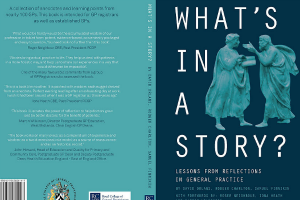Book review: What’s in a story?


‘Tell me the facts and I’ll learn. Tell me the truth and I’ll believe. But tell me a story and it will live in my heart forever.’ – Native American Proverb
Can you remember a patient that changed the way you practised? Or perhaps a case from a colleague that you knew you’d never forget?
I imagine you’re thinking of more than one.
Lectures, textbooks, and evidence-based reviews give us the knowledge we need to practise as safe and competent GPs. But it’s the stories that stay with us. Stories get to the places that PowerPoints and papers can’t reach. Stories help us to make sense of our world and to share that understanding with others, whilst keeping us both grounded and kind.
Being able to share in both the joys and the mistakes of those gone before us is both deeply humbling and reassuring
But the wisdom contained in a story can easily be lost without taking time to put pen to paper.
This book brings together a range of compelling stories from nearly a hundred GPs. It is packed with easy-to-digest, succinct anecdotes, divided into sections that cover the breadth of challenges we face – from the art of communication, to home visits, prescribing, and managing death. The sage and compassionate voices of many GPs can be heard through these tales, nearly all remarkable, and some the kind that restore one’s faith in humanity.
Every story ends with a reflection, some of which may seem obvious at first (such as ‘listen to your inner voice’, and ‘expect the unexpected’). And yet such obvious dictums are easily forgotten. The power of showing these through personal stories is far more enduring than hearing them out of context.
There are plenty more thought-provoking ones too: ‘When deciding whether to admit a patient to hospital, ask yourself if the patient would look out of place on an A&E trolley’; and (my favourite) ‘as soon as you sense things are going even slightly wrong, stop what you are saying, ask a really open question, and sit back and listen’.
The opportunities to swap stories seemed to dwindle as I moved from my hospital jobs into general practice. And yet the practise of medicine being as much an art as a science feels particularly true for the role of GPs. For me, mastering that art will come not only from the curriculum, assessment hurdles and consultation models that define our training, but from learning from the stories of my patients and colleagues.
This is a book that GPs and trainees will undoubtedly enjoy, but one I also gave to a medical student, who said it challenged many of her preconceptions of what we do each day in general practice.
Reading it felt like a privilege. It was as though I had pulled back the curtain on a lifetime of experiences from GPs ahead of me, and was being presented with the nuggets they’ve collected along their journeys. There is something about being able to share in both the joys and the mistakes of those gone before us that is both deeply humbling and reassuring.
We learn as much from our patients as we give to them. Those lessons can be gold dust, and this book has finally sieved off some of them. I know it is one that I will continue to dip in and out of as I collect my own stories going forwards.
Dr Nishma Manek is a GP trainee in Cambridge
What’s in a story by David Orlans, Rodger Charlton and Samuel Finnikin is published by Hampton-In-Arden Publishing and available online at whatsinastory.co.uk
Pulse October survey
Take our July 2025 survey to potentially win £1.000 worth of tokens










